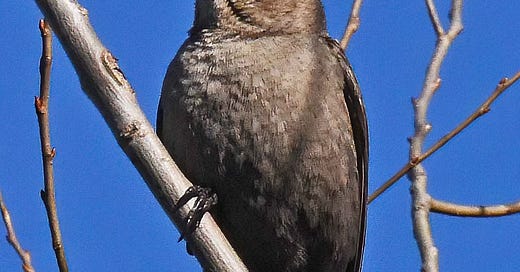May is on the doorstep. Soon, the aroma of lilac will greet me as I walk my neighborhood streets. My favorite fragrance, I wait for these purple blooms all year, and seldom will I pass a lilac bush without pausing to take in that deep and lovely aroma.
The birds in our yard are pairing off, and we love to watch the males wooing females with food offerings. I’m sure that nesting will very soon begin in earnest, and our trees will be full of home-building pairs of finches and sparrows, cardinals and jays.
But that kind of behavior won’t be happening with this bird.
This female Brown-headed Cowbird is preparing, in her own way, to provide a home for her babies. But she will not be building a nest. Rather, perching high in the branches of a tree, she is scouting. While all around her smaller birds are busy nest-building, she is looking for just the right one in which to lay her egg. Once she finds it, she will deposit it, an unwanted gift to an unsuspecting warbler or sparrow, who will then incubate the egg and raise the young cowbird, often with dire consequences to the foster parent’s own offspring. The cowbird baby is very large, and demands so much food that its adoptive nestmates often die. The mother cowbird will repeat this process up to three dozen times over the course of the summer, laying eggs in small birds’ nests and flying off, never to see the eggs or chicks again. The process has a name: brood parasitism.
It’s easy to judge, isn’t it? Labeled a parasite, known threat to endangered songbirds like the Kirtland’s Warbler, there seems little about this interloper that might endear it to birdwatchers or to human parents. But as with almost everything in this complicated world, the story of the Brown-headed Cowbird is deeper and richer than we might first imagine.
Historically, cowbirds were native to the Great Plains of the US, where they followed herds of bison, dining on insects kicked up as the bison passed. It was a nomadic lifestyle, not suited to nesting in the traditional manner; and the energy saved by forgoing nest building made it possible for cowbirds to produce a much larger number of eggs in a season than other birds. As the eastern forests were cleared for farms and towns, the cowbirds expanded, and they are now seen all over the US. We see them at our feeders, often joining flocks of grackles and Red-winged Blackbirds.
And later in the summer we sometimes see a young cowbird with its often very small and bedraggled foster mother. In the picture below, a tiny Chipping Sparrow, one of our smaller sparrows, feeds a much larger cowbird baby.
The amazing thing to me is that this baby Brown-headed Cowbird has known nothing about other cowbirds in its life. Its mother has been a Chipping Sparrow. The song it would have heard would have been the male Chipping Sparrow singing as he defended the nest that held the cowbird hatchling. Any siblings it may have had would have been the surviving Chipping Sparrow babies. And yet, as this baby matures into an adult Brown-headed Cowbird, it won’t sing the song of the Chipping Sparrow. Its song will be that of a Brown-headed Cowbird. And when it seeks a mate, it will look for that mate among the cowbirds, not the sparrows.
Despite its early experiences, this baby bird will grow to know who it is. It will know, and sing, its own song. The power of DNA , and the power of self-knowledge, will be strong enough to erase any imprint of its foster family as this young bird matures.
I think perhaps the complicated life history of this much-reviled bird may have something to teach us. We, no matter our age, are forever becoming more and more ourselves. And as we continue this journey of self-discovery, we are not unlike the young cowbird, learning the song that is ours to sing. And singing it.
To learn more about the fascinating life of the Brown-headed Cowbird:
https://www.allaboutbirds.org/guide/Brown-headed_Cowbird/overview
https://nationalzoo.si.edu/migratory-birds/news/brown-headed-cowbirds-buffalo-birds-modern-scourge






